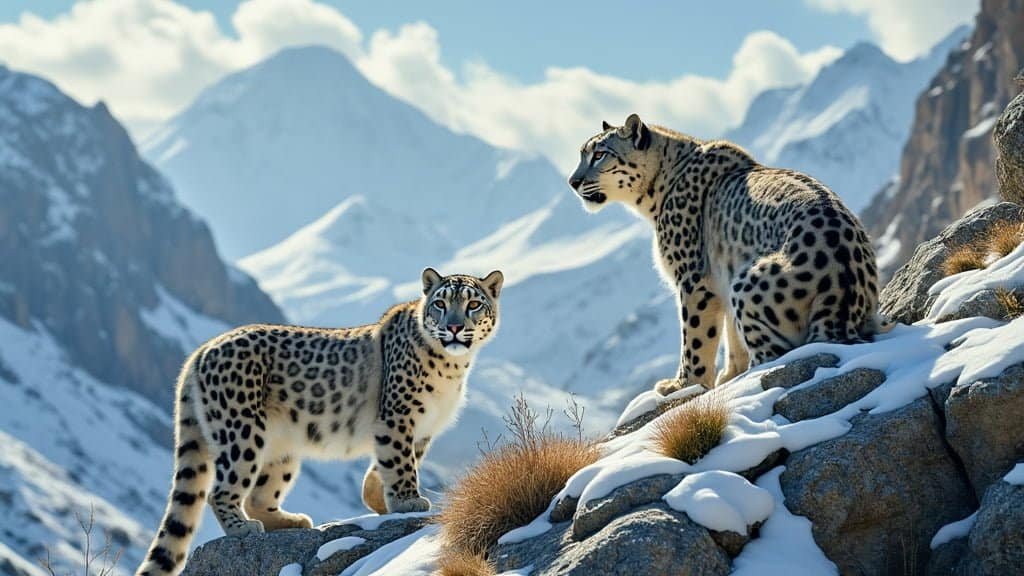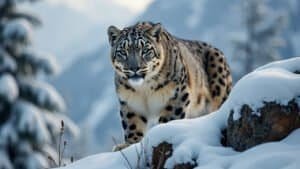Introduction
Snow leopards are elusive big cats native to the rugged terrains of the Himalayas. Over the years, their populations have fluctuated due to a variety of factors, ranging from human activities to environmental changes
This article explores the complex dynamics behind these population changes, examining the contributing factors such as human-wildlife conflict, poaching, and habitat loss. Additionally, we delve into the impact of climate change, review current population estimates, and analyze the effectiveness of conservation efforts aimed at protecting these majestic creatures
By understanding these trends, we can better appreciate the ongoing challenges and the strides being made to ensure the survival of snow leopards in the Himalayas
Factors Contributing to the Decline in Snow Leopard Populations
Snow leopards have faced significant population declines in the Himalayas due to several interrelated factors. Understanding these causes is crucial for developing effective conservation strategies
Over the decades, human activities, poaching, and habitat fragmentation have been the primary drivers of these changes, exacerbating the challenges faced by these elusive predators
Human-Wildlife Conflict
One of the most significant factors contributing to the decline in snow leopard populations is human-wildlife conflict. As human settlements and livestock farming expand into the snow leopard’s natural habitat, these big cats often prey on domestic animals, leading to retaliatory killings by local herders
The loss of livestock is a severe economic blow to herders in these remote regions, where alternative livelihoods are scarce. Consequently, the relationship between snow leopards and local communities has been fraught with tension, often resulting in the reduction of the snow leopard population
In some parts of the Himalayas, efforts have been made to mitigate this conflict through community-based programs that offer compensation for livestock losses and encourage the protection of snow leopards
For instance, organizations like the Snow Leopard Trust have established insurance schemes that compensate herders for livestock lost to predators, reducing the incentive to kill snow leopards in retaliation
Poaching and Illegal Trade
Poaching remains a critical threat to snow leopards. Despite legal protections under CITES (the Convention on International Trade in Endangered Species of Wild Fauna and Flora), illegal hunting for their fur, bones, and other body parts continues
Snow leopard pelts are highly valued on the black market, and their bones are used in traditional medicine, particularly in parts of Asia. This illegal trade has significantly impacted snow leopard populations, as poachers target these animals for financial gain
Recent studies have shown that poaching accounts for the loss of several hundred snow leopards annually. For example, a report by TRAFFIC, a wildlife trade monitoring network, revealed that between 2008 and 2016, an estimated 221 to 450 snow leopards were killed annually for illegal trade
The report highlights the urgent need for stronger enforcement of wildlife protection laws and international cooperation to combat this threat
Habitat Fragmentation
Habitat fragmentation, caused by infrastructure development, agriculture, and human encroachment, has led to the isolation of snow leopard populations
As roads, villages, and agricultural lands expand into snow leopard territory, these animals are forced into smaller, more fragmented areas, reducing their access to prey and increasing the risk of inbreeding. Fragmented habitats also make it more challenging for snow leopards to find mates, leading to a decline in genetic diversity and a higher susceptibility to disease
The construction of roads and railways in the Himalayas, aimed at boosting regional development, has further fragmented snow leopard habitats. These developments not only disrupt the natural movement of snow leopards but also increase the likelihood of human-snow leopard encounters, escalating the risk of conflict
Moreover, climate change is exacerbating habitat fragmentation by altering the snow leopard’s environment. As the tree line in the Himalayas shifts upwards due to rising temperatures, snow leopards are pushed into higher altitudes, where prey is scarcer, and the terrain is less suitable for their survival. This change in habitat dynamics could have long-term consequences for snow leopard populations if not addressed through targeted conservation efforts
To combat habitat fragmentation, conservation organizations have focused on creating and maintaining wildlife corridors that allow snow leopards to move between fragmented habitats safely. These corridors are essential for maintaining genetic diversity and ensuring the long-term survival of snow leopard populations in the Himalayas
Impact of Climate Change on Himalayan Snow Leopards
Climate change is emerging as a significant factor influencing the survival of snow leopards in the Himalayas
The delicate balance of the high-altitude ecosystems they inhabit is increasingly disrupted by rising temperatures, shifting weather patterns, and changing habitats. These environmental changes pose new challenges to snow leopard populations, threatening their ability to find food, shelter, and mates
Rising Temperatures and Shrinking Habitats
One of the most direct impacts of climate change on snow leopards is the alteration of their habitat
As global temperatures rise, the tree line in the Himalayas is gradually moving upward, encroaching on the alpine zones where snow leopards thrive. This shift reduces the available habitat for snow leopards, forcing them to higher altitudes where conditions are harsher, and prey is less abundant
A study published in Biological Conservation (2016) estimated that snow leopard habitat in the Himalayas could decline by up to 30% by 2070 due to climate-induced changes. This loss of habitat not only limits the space in which snow leopards can live but also fragments their populations, making it more difficult for them to find mates and maintain genetic diversity
Additionally, the melting of glaciers and the reduction of snow cover in the Himalayas, driven by climate change, is reducing the availability of water resources and altering the distribution of prey species. These changes further strain the snow leopard’s ability to survive in its natural habitat, leading to increased competition for resources
Changes in Prey Availability
Snow leopards primarily prey on blue sheep (bharal), ibex, and other mountain ungulates, which are also affected by climate change
As the habitats of these prey species shift due to warming temperatures, snow leopards may find it increasingly difficult to locate and hunt their traditional food sources. A decline in prey populations could lead to malnutrition and lower reproductive success among snow leopards, contributing to a decline in their numbers
Moreover, as prey species move to new areas in response to climate changes, snow leopards may be forced to follow, leading them into closer proximity with human settlements. This can exacerbate human-wildlife conflicts, as snow leopards might turn to livestock as an alternative food source when wild prey becomes scarce
Research conducted by the World Wildlife Fund (WWF) indicates that changes in prey availability due to climate change could have a cascading effect on snow leopard populations
The WWF’s climate change adaptation strategies focus on ensuring the availability of prey by protecting and managing critical habitats, thus helping to mitigate the impacts of climate change on snow leopards
Long-Term Climate Models
Long-term climate models predict that the Himalayas will continue to experience significant environmental changes throughout the 21st century
These models suggest that temperature increases could be more pronounced at higher altitudes, further accelerating habitat loss for snow leopards. The frequency and intensity of extreme weather events, such as storms and droughts, are also expected to increase, adding additional stress to snow leopard populations
The Intergovernmental Panel on Climate Change (IPCC) has highlighted the vulnerability of high-altitude ecosystems, like those in the Himalayas, to climate change. Their reports underscore the importance of integrating climate change adaptation into snow leopard conservation strategies
This includes protecting and restoring habitats that are resilient to climate change, promoting connectivity between fragmented habitats, and working with local communities to reduce the impact of climate-induced changes on both snow leopards and their prey
Current Population Estimates of Snow Leopards in the Himalayas
Estimating the population of snow leopards in the vast and remote regions of the Himalayas has always been a challenging task. However, recent advancements in technology and survey methods have provided more accurate insights into the current status of these elusive cats
Understanding the current population trends is crucial for guiding conservation efforts and ensuring the survival of snow leopards in the wild
Methods of Population Estimation
Traditionally, snow leopard populations were estimated using indirect methods such as tracking pugmarks (footprints), scat analysis, and interviewing local communities. While these methods provided valuable information, they often led to overestimates or underestimates due to the secretive nature of snow leopards and the rugged terrain they inhabit
In recent years, more sophisticated techniques have been developed to improve population estimates. Camera trapping has become one of the most effective methods for monitoring snow leopard populations
By placing motion-activated cameras in strategic locations within the snow leopard’s range, researchers can capture images of individual leopards. These images are then analyzed to identify individual animals based on their unique spot patterns, allowing for more accurate population counts
Another method that has gained popularity is genetic sampling, where DNA is extracted from snow leopard scat or hair samples. This genetic data helps to identify individual snow leopards and estimate population size with greater precision. Additionally, genetic analysis provides insights into the genetic diversity of populations, which is essential for understanding the overall health and viability of the species
Recent Surveys and Studies
Recent surveys using these advanced methods have provided updated estimates of snow leopard populations in the Himalayas
According to a 2016 study by the Global Snow Leopard and Ecosystem Protection Program (GSLEP), the estimated population of snow leopards across their entire range is between 4,000 and 6,500 individuals. However, due to the difficulties in accessing remote areas and the secretive behavior of snow leopards, these numbers remain approximate
In the Indian Himalayas, a study conducted by the Wildlife Institute of India (WII) in 2018 used camera traps and genetic analysis to estimate that there are between 400 and 700 snow leopards in the region. Similarly, surveys in Nepal have estimated the population to be around 300 to 400 individuals
In Bhutan, the population is estimated to be between 100 and 200 snow leopards. These numbers highlight the fragmented nature of snow leopard populations in the Himalayas and the need for transboundary conservation efforts
Population Distribution Across Himalayan Regions
The distribution of snow leopard populations across the Himalayan regions is uneven, with some areas harboring more individuals than others
For example, the Indian states of Jammu and Kashmir, Himachal Pradesh, and Uttarakhand are known to support significant populations of snow leopards, thanks to their vast protected areas and relatively undisturbed habitats
In Nepal, snow leopards are primarily found in the Annapurna and Kanchenjunga conservation areas, as well as in Sagarmatha (Everest) National Park. These regions offer a mix of rugged terrain, high-altitude grasslands, and abundant prey, making them ideal habitats for snow leopards
However, even within these areas, snow leopard populations are fragmented, and movement between populations is limited by natural and human-made barriers
Bhutan’s snow leopard populations are concentrated in the northern parts of the country, particularly in the Jigme Dorji National Park and Wangchuck Centennial National Park. These parks form part of a larger transboundary conservation area that extends into Tibet, providing a critical habitat corridor for snow leopards
While the exact numbers may vary, the overall trend indicates that snow leopard populations in the Himalayas remain vulnerable, with some areas showing signs of stability, while others continue to face significant threats
The uneven distribution and fragmentation of populations underscore the importance of regional cooperation in conservation efforts to ensure the survival of snow leopards across the entire Himalayan range
Conservation Efforts and Their Impact
Over the past few decades, significant efforts have been made to conserve snow leopards in the Himalayas. These efforts, led by governments, international organizations, and local communities, have aimed to address the numerous threats snow leopards face
Understanding the impact of these conservation strategies is essential to ensure the continued protection and recovery of snow leopard populations
Role of Protected Areas and National Parks
Protected areas and national parks have played a crucial role in conserving snow leopards. The establishment of these protected zones in key habitats has provided a refuge for snow leopards, reducing the impact of human activities such as poaching, habitat destruction, and human-wildlife conflict
For instance, in India, the Hemis National Park in Ladakh, established in 1981, is one of the largest national parks in South Asia and a stronghold for snow leopards
The park’s remote and rugged terrain, combined with active conservation efforts, has made it one of the most critical habitats for snow leopards in the region. Similarly, in Nepal, the Sagarmatha (Everest) National Park and the Annapurna Conservation Area are key protected areas that have significantly contributed to snow leopard conservation
In Bhutan, Jigme Dorji National Park is known for its snow leopard population and has been a focal point for conservation initiatives. These parks not only protect snow leopards but also safeguard the biodiversity of the high-altitude ecosystems they inhabit
While the establishment of protected areas has been beneficial, challenges remain, such as ensuring effective management, preventing illegal activities within park boundaries, and addressing the needs of local communities who live near or within these areas
To maximize the impact of these protected areas, ongoing efforts are required to improve enforcement, engage local communities, and expand the network of protected habitats
Community-Based Conservation Programs
Community-based conservation programs have emerged as a powerful tool in snow leopard conservation
These programs involve local communities in conservation efforts, providing them with incentives to protect snow leopards and their habitats. By fostering a sense of ownership and responsibility, these initiatives help reduce human-wildlife conflict and poaching, while also improving the livelihoods of local people
One successful example is the Snow Leopard Enterprises program, initiated by the Snow Leopard Trust
This program works with herder communities in Mongolia, India, Kyrgyzstan, and other snow leopard range countries, offering them income-generating opportunities in exchange for their commitment to protect snow leopards. By producing and selling handicrafts made from wool and other local materials, herders can earn a sustainable income, reducing their reliance on poaching or retaliatory killings of snow leopards
In Nepal, the Snow Leopard Conservation Committee (SLCC) model, developed by the National Trust for Nature Conservation (NTNC), engages local communities in monitoring snow leopard populations and managing human-wildlife conflict. The SLCCs have been instrumental in reducing poaching and promoting coexistence between humans and snow leopards in several conservation areas
Similarly, in Bhutan, community-based ecotourism initiatives have been developed to provide alternative livelihoods for local people. By promoting snow leopard-focused tourism, these initiatives generate income for communities while raising awareness about the importance of snow leopard conservation
International Collaborations and Funding
International collaborations have been vital in supporting snow leopard conservation efforts in the Himalayas
Organizations such as the World Wildlife Fund (WWF), Panthera, and the Snow Leopard Trust have partnered with local governments and communities to implement conservation programs, conduct research, and raise global awareness about the plight of snow leopards
The Global Snow Leopard and Ecosystem Protection Program (GSLEP), launched in 2013, is one of the most significant international initiatives focused on snow leopard conservation
It brings together 12 snow leopard range countries, including India, Nepal, and Bhutan, to work towards the common goal of securing 20 snow leopard landscapes by 2020. While this ambitious target has not been fully met, the program has succeeded in fostering greater collaboration and resource-sharing among range countries
Funding from international donors and organizations has also played a crucial role in supporting conservation projects. The United Nations Development Programme (UNDP) and the Global Environment Facility (GEF) have provided financial support for snow leopard conservation initiatives, particularly those focused on community-based conservation and habitat protection
These international efforts have not only contributed to the protection of snow leopards but have also helped to build local capacity for conservation. By training local rangers, researchers, and community members, these programs ensure that conservation efforts can be sustained in the long term
Conclusion
Snow leopards in the Himalayas have experienced significant population changes over time, driven by a combination of human activities, environmental shifts, and conservation efforts
The decline in their numbers was initially fueled by factors such as poaching, human-wildlife conflict, and habitat fragmentation, all of which have posed serious threats to their survival. However, the impact of climate change has added another layer of complexity, as it alters habitats and prey availability, pushing snow leopards into increasingly precarious situations
Despite these challenges, recent advancements in population monitoring and the establishment of protected areas have provided a clearer picture of snow leopard populations and offered new hope for their conservation
Community-based programs have empowered local populations to play a key role in protecting these majestic creatures, while international collaborations have pooled resources and expertise to support comprehensive conservation strategies
While progress has been made, snow leopard populations in the Himalayas remain vulnerable, and continued efforts are essential. By addressing the ongoing threats and adapting to the challenges posed by climate change, conservationists, governments, and local communities can work together to ensure that snow leopards continue to roam the high mountains of the Himalayas for generations to come












